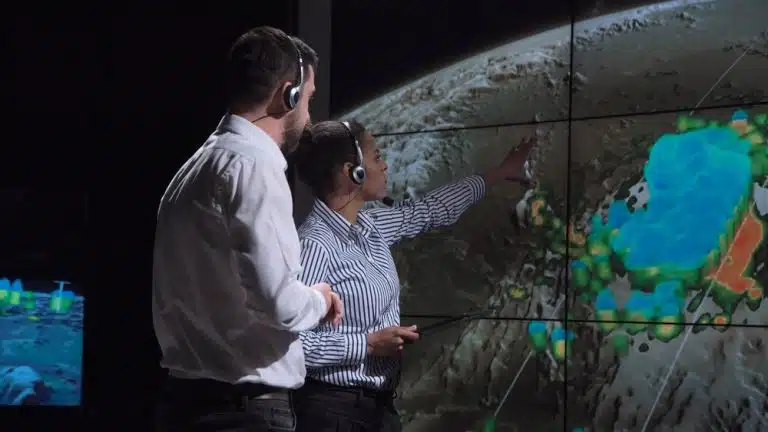If you’ve ever been fascinated by towering thunderstorms, obsessed with tracking hurricanes, or curious about how climate change affects our daily lives, then studying meteorology might be your perfect path. But with so many meteorology schools out there, how do you know which ones are the best?
In this blog, we’ve rounded up the best meteorology schools in the U.S. to help you find the right fit—whether you’re dreaming of becoming a broadcast meteorologist, a climate researcher, or a storm chaser. Ready to dive into the world of atmospheric science? Let’s explore your top options!
- Top 10 Meteorology Schools in the US
- How to Get into the Best Meteorology Schools
- Frequently Asked Questions
- Takeaways
Top 10 Meteorology Schools in the US
Here are the top 10 meteorology schools in the US based on US News and World Report that offer outstanding programs, hands-on experience, and a strong track record in atmospheric science.
1. Columbia University
Acceptance rate: 3.85%
Average tuition cost: $71,170
Columbia’s meteorology strength lies in its close partnership with the Lamont-Doherty Earth Observatory, one of the world’s leading climate research centers. If you’re looking to explore climate dynamics, atmospheric circulation, or extreme weather events, this is the place to be.
The university offers a specialized track in Atmospheric Science through its Department of Earth and Environmental Sciences, where you can work with renowned climate scientists like Dr. Adam Sobel, a prominent voice in extreme weather and hurricane research.
Columbia also plays a major role in IPCC reports and global climate policy, giving you both the academic and real-world edge. According to the National Science Foundation (NSF), Columbia ranks consistently among the top 20 schools for Earth sciences research funding.
2. University of Colorado Boulder
Acceptance rate: 81%
Average tuition cost: $7,000 (in-state)
UC Boulder is a powerhouse in atmospheric and environmental science. The Department of Atmospheric and Oceanic Sciences (ATOC) offers one of the most comprehensive meteorology programs in the country. You’ll dive deep into atmospheric chemistry, climate modeling, and space weather—yes, even space weather!
What truly sets Boulder apart is its proximity to national research hubs like NOAA’s Earth System Research Laboratory and the National Center for Atmospheric Research (NCAR), where students frequently intern and collaborate. Professors like Dr. Brian Toon, known for his work on climate engineering and planetary atmospheres, elevate the learning experience.
3. University of California Irvine
Acceptance rate: 26%
Average tuition cost: $13,146 (in-state)
UC Irvine might fly under the radar, but its Department of Earth System Science is a hidden gem in meteorology and climate studies. The program emphasizes global atmospheric dynamics, satellite remote sensing, and the connections between human activity and atmospheric change.
One of the department’s stars is Dr. Steven Davis, whose groundbreaking work in global emissions tracking and climate feedback has earned international acclaim. UCI is also home to the Center for Hydrometeorology and Remote Sensing (CHRS), where students gain experience with weather data and flood forecasting tools used worldwide.
4. California Institute of Technology
Acceptance rate: 2.3%
Average tuition cost: $65,622
Caltech may be best known for engineering and physics, but it’s also a leader in atmospheric science thanks to its Environmental Science and Engineering (ESE) program. Here, meteorology intersects with physics, data science, and planetary science in ways few other schools offer.
Students benefit from collaborations with NASA’s Jet Propulsion Laboratory (JPL), located just down the road, where real-time satellite data and atmospheric modeling fuel cutting-edge research. Faculty like Dr. Tapio Schneider, a pioneer in climate system modeling, bring prestige and depth to the curriculum.
5. University of Maryland College Park
Acceptance rate: 45%
Average tuition cost: $11,505 (in-state)
UMD stands out as a national leader in weather forecasting and satellite meteorology, driven by its strong partnership with NOAA’s Center for Weather and Climate Prediction, located right on campus. Through its Department of Atmospheric and Oceanic Science (AOSC), students can take specialized courses in:
- numerical weather prediction
- satellite remote sensing
- climate variability
The faculty roster includes influential names like Dr. Eugenia Kalnay, a legend in ensemble forecasting and data assimilation. UMD also houses the ESSIC (Earth System Science Interdisciplinary Center), a major research center that coordinates with NASA, NOAA, and other agencies.
6. Harvard University
Acceptance rate: 3.6%
Average tuition cost: $56,550
While Harvard doesn’t offer a traditional undergraduate meteorology major, it excels in atmospheric science through its Department of Earth and Planetary Sciences (EPS). The university’s approach is interdisciplinary, integrating meteorology with environmental science, climate physics, and planetary atmospheres.
One of the program’s shining stars is Dr. Daniel Jacob, a globally recognized expert in atmospheric chemistry and satellite remote sensing, particularly in air quality and climate change.
Harvard researchers play key roles in NASA’s GEOS-Chem project, a leading atmospheric chemistry model used worldwide. Harvard also boasts one of the highest research expenditures per faculty member in Earth sciences, and students benefit from access to the Harvard Forest and Center for the Environment, offering long-term climate data and modeling tools.
7. University of Washington Seattle
Acceptance rate: 43%
Average tuition cost: $12,973 (in-state)
UW Seattle’s Department of Atmospheric Sciences is consistently ranked among the top meteorology programs in the nation. What makes it stand out is its depth; students can explore areas like:
- cloud microphysics
- storm dynamics
- climate modeling
- weather radar
The program is home to influential researchers like Dr. Cliff Mass, who’s well-known in both academic and public weather communities. UW is also a leader in Arctic climate research, collaborating with NOAA’s Pacific Marine Environmental Lab and the Polar Science Center.
UW’s atmospheric sciences maintained its position as No. 1 in the world on the Global Ranking of Academic Subjects list for 2023. Its location in the Pacific Northwest—where weather is dynamic and data-rich—makes it an incredible place to study meteorology in action.
8. University of California San Diego
Acceptance rate: 26.8%
Average tuition cost: $20,571 (in-state)
UC San Diego is a standout thanks to its world-renowned Scripps Institution of Oceanography, which houses the school’s atmospheric science program. This makes it a top choice for students interested in fields like:
- climate systems
- atmospheric-ocean interactions
- Paleoclimatology
Professors like Dr. Veerabhadran Ramanathan—famous for discovering the warming effect of CFCs and black carbon—have brought international attention to UCSD’s contributions to climate science. Students work directly with tools like global climate models and atmospheric chemistry sensors, participating in high-impact research on climate policy and global sustainability.
9. University of California Los Angeles
Acceptance rate: 9%
Average tuition cost: $15,154 (in-state)
UCLA’s Department of Atmospheric and Oceanic Sciences (AOS) offers one of the most flexible and research-intensive meteorology programs in California. It stands out for its strengths in the following fields:
- climate variability
- weather forecasting
- tropical meteorology
- environmental fluid dynamics
Students have access to cutting-edge research facilities like the Joint Institute for Regional Earth System Science and Engineering (JIFRESSE), a collaboration between UCLA and NASA’s Jet Propulsion Lab. Notable faculty include Dr. Alex Hall, a leading voice in regional climate change and extreme heat research.
10. Princeton University
Acceptance rate: 4.6%
Average tuition cost: $65,210
Princeton’s meteorology strength comes from its unique collaboration with the Geophysical Fluid Dynamics Laboratory (GFDL)—one of the most influential climate modeling institutions in the world. Through its Program in Atmospheric and Oceanic Sciences, students study topics like climate dynamics, atmospheric circulation, and global modeling, often contributing directly to national climate assessments.
Faculty like Dr. Isaac Held and Dr. Gabriel Vecchi are renowned for their work in climate modeling and hurricane variability, respectively. Princeton’s students frequently publish alongside researchers at GFDL, and the school has one of the highest rates of atmospheric science PhD graduates entering federal research labs.
How to Get into the Best Meteorology Schools
Interested in pursuing meteorology and atmospheric science in college? Here are our best strategies to make the process smoother for you:
1. Build a solid STEM foundation early.
Meteorology is a science that lives at the intersection of mathematics, physics, and environmental science. Top schools like Columbia and Caltech recommend incoming students have a strong background in calculus, algebra-based or calculus-based physics, and chemistry.
According to the American Meteorological Society (AMS), over 90% of meteorology programs require at least one year of calculus and physics. The more rigorous your high school coursework, the more competitive your application will be.
2. Get comfortable with computers and coding.
Weather forecasting and climate modeling rely heavily on computational tools and programming languages. The best meteorology schools integrate Python, Fortran, MATLAB, and R into their meteorology curriculum.
According to insights from the American Meteorological Society, meteorologists who are also programmers are a growing trend in today’s workforce. Learning to code in high school—via courses, bootcamps, or self-study—will help you hit the ground running.
3. Join weather-related clubs or competitions.
Get involved in extracurriculars that showcase your interest in meteorology. For example, Science Olympiad includes Meteorology and Dynamic Planet events, where students apply real-world forecasting and geophysical knowledge. Participating in national competitions or starting a weather blog can help your application stand out.
4. Volunteer or intern with local weather stations or agencies.
Gaining real-world experience—like interning at a National Weather Service (NWS) field office, local TV station, or with an environmental nonprofit—gives you practical insight and connections. The NWS even offers Student Volunteer Programs and summer internships at over 120 locations nationwide. These experiences also give you strong material for recommendation letters and personal statements.
5. Ace your application essays with meteorology in focus.
Top-tier meteorology schools want to see why you’re passionate about the field. Tell your personal story—maybe it was witnessing a tornado, growing up in hurricane country, or a science fair project that inspired you.
For your college applications, essays can tip the scale for 25% of applicants in selective admissions. Use your essay to demonstrate your curiosity, commitment, and long-term goals in atmospheric sciences.
6. Get involved in research early.
Some high schools offer opportunities to conduct independent science research or take part in science fairs like the Regeneron ISEF (International Science and Engineering Fair), where atmospheric science projects often win top prizes.
Students who engage in research demonstrate critical thinking, problem-solving, and the ability to work with data—skills highly valued by the best meteorology schools. For example, programs like Columbia University and Harvard give priority to applicants with proven research potential.
7. Reach out to professors or departments.
Don’t be afraid to email meteorology departments with questions about their curriculum, labs, or undergrad opportunities. Mention a specific professor’s research that excites you—it shows that you’ve done your homework.
This kind of demonstrated interest can matter; a 2023 NACAC study found that 16% of colleges track demonstrated interest in admission decisions.
8. Take AP or dual enrollment courses in relevant subjects.
If your school offers AP Physics, AP Calculus, AP Environmental Science, or college-level Earth science classes, take them. The best meteorology programs often accept AP credits toward general requirements, giving you flexibility to dive into major-specific courses earlier. The best meteorology schools recommend AP-level coursework as prep for majors in atmospheric science.
9. Explore summer programs and pre-college experiences.
Programs like NCAR’s Summer Internships, the NOAA Hollings Scholarship, or university-hosted pre-college programs provide hands-on experiences in meteorology and climate science.
These programs are competitive and prestigious: for instance, the Hollings Scholarship supports 120+ undergraduate students and 75% of graduates go on to graduate schools. These opportunities show commitment and give your resumé a serious boost.
10. Highlight your passion—not just your GPA.
Grades and test scores matter, but admissions teams at the best meteorology schools want to know who you are beyond the numbers. Are you the kind of person who watches radar maps for fun? Do you track hurricanes or publish weather breakdowns on social media?
That passion—especially when turned into a project, blog, or club—can be more compelling than a perfect GPA. In competitive schools like UC Irvine or Columbia, where many applicants have top scores, your personal story and drive can make all the difference.
Frequently Asked Questions
1. What is the job outlook for meteorology graduates in 2025?
Employment of atmospheric scientists, including meteorologists is projected to grow 6% from 2023 to 2033, faster than the average for all occupations. Each year over the next decade, about 900 openings are expected for atmospheric scientists, including meteorologists.
2. What is the average salary for meteorologists?
The average salary for meteorologists in the US is $67,390.
3. Do I need to major specifically in meteorology to become a meteorologist?
Not necessarily. Many students major in atmospheric science, climate science, environmental science, or physics. However, if you plan to work as a certified broadcast or operational meteorologist, it’s best to attend a program that meets American Meteorological Society (AMS) or National Weather Service coursework standards, which are typically found at the best meteorology schools.
Takeaways
- Some of the best meteorology schools include Columbia University, UC Boulder, UC Irvine, Caltech, and UMCP.
- Choosing from the best meteorology schools in the US is about finding a program that fits your passion for weather, climate, and science. Whether you’re drawn to storm chasing, climate modeling, or atmospheric research, the right school can help you turn your curiosity into a career.
- If you’re aiming for a top-tier meteorology program, our college admissions experts can help you craft a standout application tailored to your dream school.





